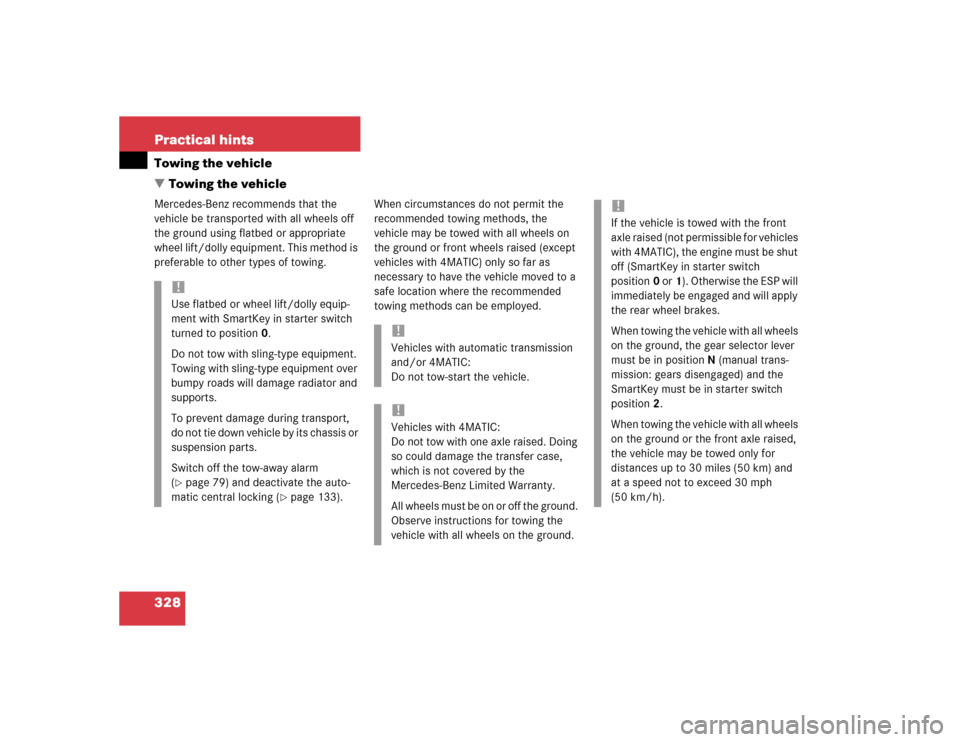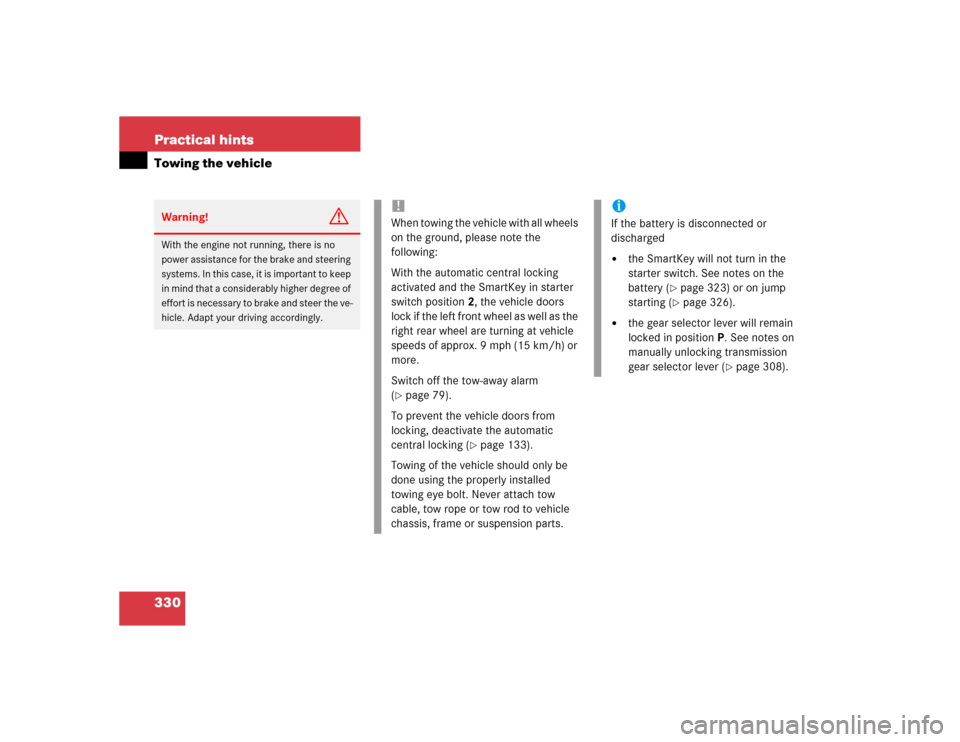Page 324 of 400

324 Practical hintsBattery1Negative terminal
2Positive terminal cover
Disconnecting the battery�
Turn off all electrical consumers.
�
Open the hood (
�page 252).
�
Remove the filter box (
�page 323).
�
Disconnect battery negative lead1.
�
Remove cover2 from positive
terminal.
�
Disconnect the battery positive lead.
Removing the battery�
Remove the screw-nuts securing the
battery.
�
Remove the battery bracket.
�
Take out the battery.
Charging and reinstalling the battery�
Charge battery in accordance with the
instructions of the battery charger
manufacturer.
�
Reinstall the charged battery. Follow
the previously described steps in
reverse order.
Warning!
G
With a disconnected battery�
you will no longer be able to turn the
SmartKey in the starter switch
�
the gear selector lever will remain
locked in positionP
Warning!
G
Never charge a battery while still installed in
the vehicle. Gases may escape during charg-
ing and cause explosions that may result in
paint damage, corrosion or personal injury.
Page 325 of 400
325 Practical hints
Battery
Reconnecting the battery�
Turn off all electrical consumers.
�
Connect the positive lead and fasten its
cover2.
�
Connect negative lead1.
�
Reinstall the filter box (
�page 323).Batteries contain materials that can harm
the environment if disposed of improperly.
Large 12 volt storage batteries contain
lead. Recycling of batteries is the preferred
method of disposal. Many states require
sellers of batteries to accept old batteries
for recycling.
!NEVER invert the terminal connections!!The battery, its filler caps and the vent
tube must always be securely installed
when the vehicle is in operation.
iThe following procedures must be
carried out following any interruption of
battery power (e.g. due to reconnec-
tion):�
Set the clock (
�page 126).
Vehicles with COMAND*:
See COMAND operator’s manual.
�
Resynchronize the ESP
(�page 282).
�
Resynchronize side windows
(�page 202).
�
Resynchronize sliding/pop-up
roof* (
�page 205).
Page 328 of 400

328 Practical hintsTowing the vehicle
�Towing the vehicleMercedes-Benz recommends that the
vehicle be transported with all wheels off
the ground using flatbed or appropriate
wheel lift/dolly equipment. This method is
preferable to other types of towing.When circumstances do not permit the
recommended towing methods, the
vehicle may be towed with all wheels on
the ground or front wheels raised (except
vehicles with 4MATIC) only so far as
necessary to have the vehicle moved to a
safe location where the recommended
towing methods can be employed.
!Use flatbed or wheel lift/dolly equip-
ment with SmartKey in starter switch
turned to position0.
Do not tow with sling-type equipment.
Towing with sling-type equipment over
bumpy roads will damage radiator and
supports.
To prevent damage during transport,
do not tie down vehicle by its chassis or
suspension parts.
Switch off the tow-away alarm
(�page 79) and deactivate the auto-
matic central locking (
�page 133).
!Vehicles with automatic transmission
and/or 4MATIC:
Do not tow-start the vehicle.!Vehicles with 4MATIC:
Do not tow with one axle raised. Doing
so could damage the transfer case,
which is not covered by the
Mercedes-Benz Limited Warranty.
All wheels must be on or off the ground.
Observe instructions for towing the
vehicle with all wheels on the ground.
!If the vehicle is towed with the front
axle raised (not permissible for vehicles
with 4MATIC), the engine must be shut
off (SmartKey in starter switch
position0 or1). Otherwise the ESP will
immediately be engaged and will apply
the rear wheel brakes.
When towing the vehicle with all wheels
on the ground, the gear selector lever
must be in positionN (manual trans-
mission: gears disengaged) and the
SmartKey must be in starter switch
position2.
When towing the vehicle with all wheels
on the ground or the front axle raised,
the vehicle may be towed only for
distances up to 30 miles (50 km) and
at a speed not to exceed 30 mph
(50 km/h).
Page 329 of 400

329 Practical hints
Towing the vehicle
!
To be certain to avoid a possibility of
damage to the drive train, however, we
recommend the drive shaft be discon-
nected at the rear axle drive flange
(vehicles with 4MATIC: disconnected at
the front and rear axle drive flanges) for
any towing beyond a short tow to a
nearby garage.
Warning!
G
If circumstances require towing the vehicle
with all wheels on the ground, always tow
with a tow bar if:�
the engine will not run
�
there is a malfunction in the power
supply or in the vehicle’s electrical
system
as that will be necessary to adequately
control the towed vehicle.
Prior to towing the vehicle with all wheels on
the ground, make certain that the SmartKey
is in starter switch position2.
If the SmartKey is left in starter switch
position0 for an extended period of time, it
can no longer be turned in the switch. In this
case, the steering is locked. To unlock,
remove SmartKey from starter switch and
reinsert.
iTo signal turns while being towed with
the hazard warning flasher in use, turn
SmartKey in starter switch to
position2 and activate the combina-
tion switch for the left or right turn
signal in the usual manner – only the
selected turn signal will operate.
Upon canceling the turn signal, the
hazard warning flasher will operate
again.
Page 330 of 400

330 Practical hintsTowing the vehicleWarning!
G
With the engine not running, there is no
power assistance for the brake and steering
systems. In this case, it is important to keep
in mind that a considerably higher degree of
effort is necessary to brake and steer the ve-
hicle. Adapt your driving accordingly.
!When towing the vehicle with all wheels
on the ground, please note the
following:
With the automatic central locking
activated and the SmartKey in starter
switch position2, the vehicle doors
lock if the left front wheel as well as the
right rear wheel are turning at vehicle
speeds of approx. 9 mph (15 km/h) or
more.
Switch off the tow-away alarm
(�page 79).
To prevent the vehicle doors from
locking, deactivate the automatic
central locking (
�page 133).
Towing of the vehicle should only be
done using the properly installed
towing eye bolt. Never attach tow
cable, tow rope or tow rod to vehicle
chassis, frame or suspension parts.
iIf the battery is disconnected or
discharged�
the SmartKey will not turn in the
starter switch. See notes on the
battery (
�page 323) or on jump
starting (�page 326).
�
the gear selector lever will remain
locked in positionP. See notes on
manually unlocking transmission
gear selector lever (
�page 308).
Page 333 of 400
333 Practical hintsFuses
Fuse box in engine compartment
The fuse box is located in the engine
compartment on the left hand side.
1Screw
2Cover
3RetainerRemoving/installing cover
�
Twist screws1
90° counterclockwise.
�
Pull up cover2.
�
Slide out retainer3 and remove cover
by pulling towards front.
�
Install cover2 in reverse order.Opening fuse box
4Fuse box cover
5Clamps
�
Release clamps5.
�
Remove cover4.
Closing fuse box
�
Ensure that the sealing rubber is
properly positioned.
�
Press cover4 down and secure with
clamps5.
Page 355 of 400

355 Technical data
Fuels, coolants, lubricants, etc.
When switching fuels, make sure:�
Fuel level is below half full.
�
Fuel level is above reserve (fuel reserve
warning lamp is not lit).
�
Amount of added fuel is more than
5 gallons (20 liters).
�
Ignition is off during refill.
�
Immediately after refueling engine is
started and operated for at least five
minutes.
These precautions and recommendations
are supposed to prevent any difficulties
when starting and operating the engine
which otherwise may be experienced
before the engine has fully adapted to the
different fuel.
If in spite of these recommendations the
engine does not perform properly, adding
more gasoline [at least 3 gallons
(12 liters)] to the fuel may improve the
engine behavior.Cold weather performance
It is possible that starting times will signif-
icantly increase at temperatures
below 32°F (0°C). At low temperatures
the use of a block heater (Canada only) is
recommended (see your authorized
Mercedes-Benz Center for further
information). Rough idling may also be
experienced at such temperatures before
the engine is fully warmed up.
Hot weather performance
At ambient temperatures above 95°F
(35°C) start times may increase and be
accompanied by a rough idle following the
start.Cruising range
E85 fuel contains less energy per gallon
than gasoline. To ensure that engine per-
formance with Ethanol fuel is similar to
that when using gasoline, the engine must
burn more Ethanol fuel. As a result, it is to
be expected that the fuel consumption will
increase when using E85 compared to
gasoline operation.
Maintenance
Please inform your Mercedes-Benz Center
if you use or have used E85 fuel when your
vehicle is delivered for maintenance or
repairs.
!E85 fuel is unsuitable for use when
ambient temperatures fall below 14°F
(-10°C).
iUse of E85 may reduce your driving
range.
Page 361 of 400

361 Technical terms
ABS
(A
ntilock B
rake S
ystem)
Prevents the wheels from locking up
during braking so that the vehicle can
continue to be steered.
Alignment bolt
Metal pin with thread. The centering
pin is an aid used when changing a tire
to align the wheel with the wheel hub.
BabySmart
TM1
airbag deactivation
system
This system detects if a special system
compatible child restraint seat is
installed on the front passenger seat.
The system will automatically deacti-
vate the passenger front airbag when
such a seat is properly installed
(PASS. AIRBAG OFF indicator lamp
located in the center console comes
on). See your authorized
Mercedes-Benz Center for availability. BabySmart
TM compatible child seats
Special restraint system for children.
The sensor system for the passenger
seat prevents deployment of the
passenger front airbag if a
BabySmartTM compatible child seat is
installed.
BAS
(B
rake A
ssist S
ystem)
System for potentially reducing braking
distances in emergency braking
situations. The system is activated
when it senses an emergency based on
how fast the brake is applied.
Bi-Xenon headlamps*
Headlamps which use an electric arc as
the light source and produce a more
intense light than filament headlamps.
Bi-Xenon headlamps produce low
beam and high beam.CAC
(C
ustomer A
ssistance C
enter)
Mercedes-Benz customer service
center, which can help you with any
questions about your vehicle and
provide assistance in the event of a
breakdown.
CAN system
(C
ontroller A
rea N
etwork)
Data bus network serving to control
vehicle functions such as door locking
or windshield wiping depending on
vehicle settings and/or ambient
conditions.
Cockpit
All instruments, switches, buttons and
indicator/warning lamps in the
passenger compartment needed for
vehicle operation and monitoring.
1BabySmart
TM is a trademark of Siemens
Automotive Corp.